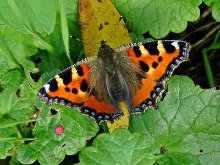
| Butterfly Conservation |
 |
| Hertfordshire & Middlesex Branch |
 |
|
|||
| Saving butterflies, moths and our environment | ||||


Small TortoiseshellAglais urticaeWidespread and common Distribution and Status The Small Tortoiseshell is a common and widespread resident although there has been an alarming reduction in numbers since the mid 1990s. It was thought that a parasitic fly Sturmia bella was largely responsible for the decline. However, numbers picked up spectacularly in 2013 and 2014 although the last few years have seen abundance drop again still indicating a significant long-term downward trend. Malcolm Hull's observations of hibernating adults in his shed suggest there could be a 'lost generation' (second brood) - see below for link to his article. Another possible reason for the decline is the application of neonicotinoid pesticides on field margins where wild flowers and larval foodplants can absorb chemicals adversely impacting insects including butterflies (Gilburn et al.) Habitat Requirements Almost anywhere from gardens to mountains but it is most abundant where nettles abound Larval Foodplants Common Nettle Urtica dioica, Small Nettle Urtica urens Adult Food Sources Heather Erica sp., Buddleia Buddleja davidii, Creeping Thistle Cirsium arvense, Hemp Agrimony Eupatorium cannabinum Behaviour/Observation notes It usually spends mornings feeding and basking so this is probably the best time of day to get close-up views and take photographs. Males set up territories in the afternoon on nettle beds and mating occurs often very late in the day, which is partly the reason why few photographs of mating pairs are captured Life History The Small Tortoiseshell usually produces two broods a year. Overwintering adults often appear on the first warm days of the year, even early as January and continue flying until early May. The first new generation emerges in around June and although most of these adults go into hibernation some will produce another brood in August. Populations are subject to immigration and emigration so numbers can vary enormously. Females lay eggs on nettles in mostly open and sheltered situations, and prefer young fresh shoots of the plant. Larvae construct a chain of webs at the top of the nettles from which they feed. When fully grown they disperse to pupate attached to a leaf or stem Further information
The Lost Generation - Malcolm Hull References
Gilburn, A.S., Bunnefeld, N., Wilson, J.McVean, Botham, M.S., Brereton, T.M., Fox, R.,
Goulson, D. (2015), Are neonicotinoid insecticides driving declines of widespread butterflies? https://peerj.com/articles/1402/ |
Copyright Butterfly Conservation © 2019 Hertfordshire & Middlesex Branch
Privacy and Copyright Statement and Cookie Policy Statement
Butterfly Conservation
Company limited by guarantee, registered in England (2206468)
Registered Office: Manor Yard, East Lulworth, Wareham, Dorset, BH20 5QP. Tel: 01929 400 209
Charity registered in England & Wales (254937) and in Scotland (SCO39268). VAT No. GB 991 2771 89